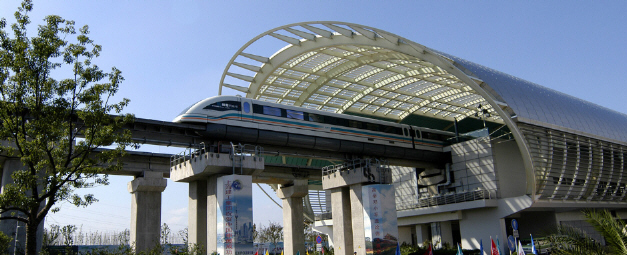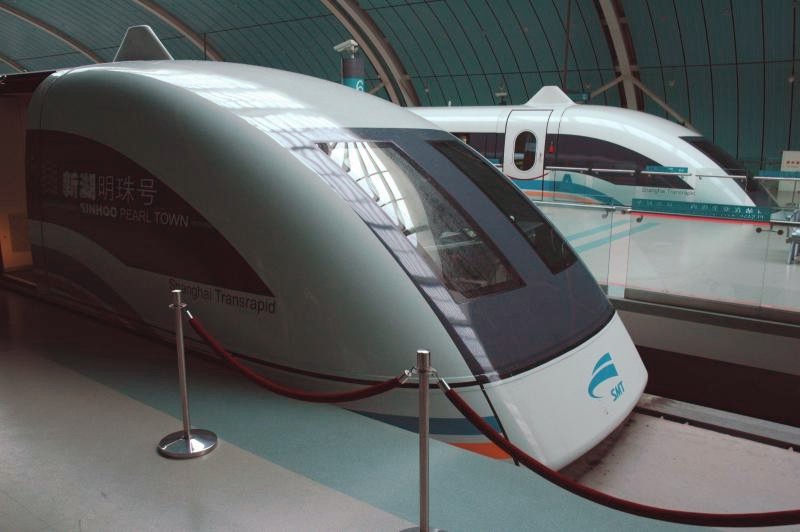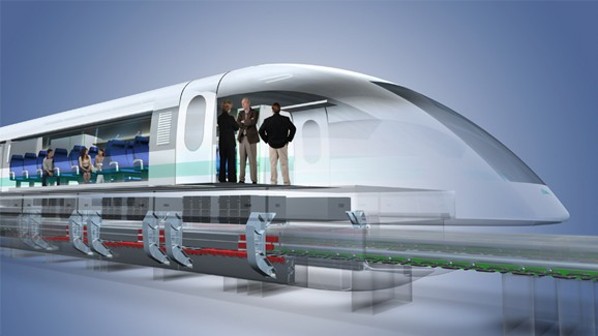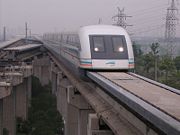Concept
A high speed Maglev Monorail between Melbourne CBD, Avalon Airport and Geelong.
Melbourne-Geelong travel time is likely to be about 12 minutes with service intervals of about 6 minutes.
Trains would travel below 250 km/h in urban areas but accelerate to over 450 km/h between Avalon and Footscray. Sound barriers would keep noise levels similar to existing freeway and railway noise levels.
Value capture opportunities exist from making Avalon Melbourne's second airport and from developing "Tottenham City" on wasteland in Melbourne's west.
Approximate Route
The approximate route of the proposed Melbourne Geelong Maglev is shown below.
|
View Geelong-Avalon-Melbourne Maglev in a larger map Approximate route of the Melbourne - Avalon - Geelong Maglev. |
Currently the Melbourne - Geelong train takes about an hour. The new $A3 billion Regional Rail Link slows down trains as the new route is longer than the old one and involves more stops.
A high-speed maglev monorail can easily be routed above the existing roads and railway lines. Approximate distance is about 72 km depending on the exact alignment.
The existing conventional rail line could provide an improved stopping-all-station service that would now have more capacity to pick up passengers along the route given that it will not be full of Geelong-Melbourne passengers.
Pillars
The pillars are to be covered in hardy creepers such as Ficus pumila (below) and hanging plants of various types. The pillars will contain an irrigation system capable of keeping these plants alive in harsh weather.

Stations

A Shanghai maglev station. |
Three stations are to be provided on this link. These stations should be built to accommodate trains of up to ten carriages which requires the platforms to be 260 meters long.
Geelong Station
The station would be located next to the existing railway station to provide good interchange with rail and bus services. (Existing rail services would provide a 'stopping-all-station' service to Melbourne.)
Avalon Airport Station
This partially underground station could be situated in an existing carpark and linked to the main terminal by high-capacity Travelators. The Maglev Track would be located in a shallow covered tunnel in the main airport presinct.
Tottenham City Station
This could be developed as a value-capture opportunity on low-value industrial land in Melbourne's west. Currently this is a blighted semi-abandoned area that could be turned into another CBD hub for Melbourne.
Southern Cross Station
At the Melbourne end of the line new Maglev platforms are to be constructed over Wurundjeri Way adjacent to the existing Southern Cross Station. These new platforms would provide immediate access to the rest of the station, Collins street, Bourke Street footbridge, Etihad stadium and to the Melbourne CBD. Air bridges could also be built from the Maglev platform concourse to the buildings on the west side of Wurundjeri Way to improve the link to the Docklands area.
See also this Station Map (PDF) for Southern Cross Station.

Shanghai Maglev Trains at Longyang Station (www.focusonmicroscopy.org ) |
Station Layout
The proposed stations have three platforms each like those shown above. Passengers enter trains via the central platform boarding whichever train comes first. Departing passengers leave via whichever edge platform their train arrives next to. Exit side doors open first to allow passengers to start clearing the carriages on one side before passengers start boarding from the other side.
Operation
Three trains would be used to shuttle passengers from the city to the Geelong.
No timetable would be used due to the short service frequency. Instead trains will run as often as they can to deliver the best service possible at any given time.
At this stage it is anticipated that all Trains would stop at Avalon Airport due to the difficulty of mixing 450 km/h+ express trains with stopping all stations trains.

|
Passenger counters on the platform gates should ensure that there is a seat for everyone although standing in the aisle would be permitted.
Trains

Transrapid TR09 interior. This shows 2 x 2 seating. We would use 2 x 3 for most seating given the 3.7 meter wide carriages. Trains would not contain toilets or cafes given the short duration of the journey. |
Initially trains could consist of just two end carriages. As passenger load increases up to eight central carriages can be added to create a train up to 10 carriages long. With a mixture of first and second class seating a ten-carriage train would carry about 900 passengers.
Maglev trains are fully automated. We would place the train operator in a central cabin allowing passengers to choose seats at the front of the train if they wished.
Capital Cost
Capital cost would be around $3 billion for the dual-track, three stations and three five-carriage trains. The trains could be expanded to ten carriages later and service intervals can be reduced to three minutes.
The owners of Avalon Airport woube be major beneficiaries of the project as Avalon would become Melbourne's primary airport as it is now 8 minutes from the CBD. A contribution of $1 billion would be reasonable.
In addition the government would need to purchase space for the maglev pillars where the maglev was not running over government owned land or Avalon Airport.
Use the calculator below to determine the cost per week for each benefitting household.
This script provided by JavaScript Kit
There are about 113,000 households in Geelong and 1,400,000 in Melbourne. The Melbourne-Geelong Maglev would allow Avalon to become the second airport for Melbourne so would be of some benefit to Melbourne residents. Traffic in the Western Suburbs would be reduced due to a reduction in the people driving to Melbourne from Geelong and increased space on the existing Geelong-Melbourne train which could stop-all-stations through the Western Suburbs.

